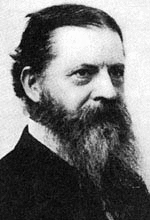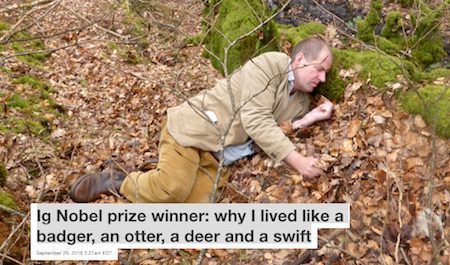Marc Abrahams's Blog, page 248
September 29, 2016
September mini-AIR: The new Ig Nobel winners (plus cinnamon research)
 The September issue of mini-AIR (our monthly e-mail newsletter) just went out. (mini-AIR is a wee little supplement to the magazine itself). Topics include:
The September issue of mini-AIR (our monthly e-mail newsletter) just went out. (mini-AIR is a wee little supplement to the magazine itself). Topics include:
The 2016 Ig Nobel Prize winners
Eating Cinnamon Converts Poor Learners Who Are Mice
“Reading Cinnamon Activates Olfactory Brain Regions”
and more
It also has info about upcoming events.
Mel [pictured here] says, “It’s swell.”
mini-AIR is the simplest way to keep informed about Improbable and Ig Nobel news and events.
Want mini-AIR e-mailed to you every month? Just opt in!

Finding grizzly: funding Troy
Troy Hurtubise, who was awarded the 1998 Ig Nobel Prize the field of safety engineering — for developing, and personally testing a suit of armor that is impervious to grizzly bears, is still crowdfunding his new project, which is called PROJECT GRIZZLY 2. Troy explains:
Project Grizzly was Quentin Tarantino’s favorite movie of 1996: a documentary following North Bay inventor and conservationist, Troy Hurtubise, on his quest to test a protective suit against a real grizzly bear. Now, two decades later, Troy seeks to finally have the encounter with his new suit the Ursus Mark VIII.
The money is being raised to finance Troy’s second expedition to the Rocky Mountains with the original film crew and the construction of the Ursus Mark VIII. Any donations surpassing $50, 000 or more will guarantee the individual a spot on the expedition with Troy and a cameo in the film. Filming for the expedition will begin in July of 2016.
The continuation of Project Grizzly, which cemented Troy’s Legacy, was used as a significant stepping stone for his ongoing career as an inventor. Some of these creations have been featured multiple times on discovery channel and other major networks. The sequel to Project Grizzly, Project Grizzly 2: The Forbidden Trail, will show a detailed look at some of his most famous creations and many new ones. Help fund the epic conclusion to an adventure that is two decades in the making and, for the more daring, take this opportunity to be apart of it.
Back in May of this year (2016), the new project was hardly more than a glint in Troy’s mind. Now it is closer to being a reality. Troy seeks to raise $770K in crowdfunding. Pledges have already reached the $400 level, by legend the most difficult part.
Here is the original Project Grizzly, a documentary film produced by the National Film Board (NFB) of Canada, about Troy and his early adventures (yes, there were later adventures, in plentitude, Troy being the nearest real thing we have, in modernity, to the legendary questing knights of the time of King Arthur):
Troy has grit, drive, persistence, deep inner fortitude, and git-up-and-go, in abundance. As an additional source of funding for his new research, Troy is reluctantly selling one of his many inventions, the R-light (” ‘R’-light embodies a collection of varying electromagnetic fields and other principle forces within a closed, semi-vaccum containment field. As the collective energy of the whole becomes one unified singular, a staggered, photonic beam is created.”). That historic invention is now available on EBay (however, for reasons unstated, it “may not ship to the U.S.”).

A one-person conversation about living in the wild à la several different animals
The Conversation invited Charles Foster to have one side of a conversation about his experiences living as animals. A few days ago, Foster shared the 2016 Ig Nobel Prize for biology. That prize was awarded jointly to Charles Foster, for living in the wild as, at different times, a badger, an otter, a deer, a fox, and a bird; and to Thomas Thwaites, for creating prosthetic extensions of his limbs that allowed him to move in the manner of, and spend time roaming hills in the company of, goats.
Here is the beginning of Charles Doster’s Conversation conversation:
I have lived as a badger in a hole in a Welsh wood, as an otter in the rivers of Exmoor, an urban fox rummaging through the dustbins of London’s East End, a red deer in the West Highlands of Scotland and on Exmoor, and, most hubristically, a swift, oscillating between Oxford and West Africa. For this I was recently awarded an Ig Nobel Prize for “achievements that make people laugh, and then think.” Why I did this is not an unreasonable question. There are many answers. One is that I wanted to perceive landscapes more accurately.
We have at least five senses. By and large we use only one of them – vision. That’s a shame. We’re missing out on 80% of the available information about the world. I suspect it’s responsible for lots of our uncertainty about the sort of creatures we are, our personal crises, and the frankly psychopathic way in which most of us treat the natural world. If we only perceive 20% of something, we’re unlikely to be able to relate appropriately to it.
In fact, it’s rather worse than this….

The pleasures of watching ironically-enjoyed movies (new study)
“So-called ‘trash films’ do not stand in opposition to taste and education. Quite the contrary, they are often watched by people with an above-average education and interest in culture.” – informs a recent online article from Max-Planck-Gesellschaft, München, Germany. The ‘delight-in-cheapness’ they are referring to is analysed in a paper for the journal Poetics Volume 57, August 2016, pp. 40–54 : it’s entitled ‘Enjoying trash films: Underlying features, viewing stances, and experiential response dimensions’.
Authors Dr. Keyvan Sarkhosh and Prof. Dr. Winfried Menninghaus of the Max Planck Institute for Empirical Aesthetics, Frankfurt, Germany, conducted an online survey presented to regular consumers of trash films. Films that were associated with the notion of trash and mentioned by at least 5% of the participants are shown in this table :
The clear ‘winners’ being Sharknado (2013) and Plan 9 from Outer Space (1959).
“Our study contributes to a better understanding of how particular audiences express a distinctive cultural taste by enjoying and appreciating specific cultural objects which deviate from the mainstream standard.”
Note: The late Don Featherstone, 1996 Ig Nobel prizewinner, was the creator of the plastic pink flamingo which played a prominent role in (the title of) John Waters’ movie Pink Flamingos (1972) – number eight in the trash list.
Also see: The pleasures of listening to ironically-enjoyed music (new study)

September 28, 2016
Podcast 83: Journeys of Toothbrushes
Toothbrushes journey — somehow, and other — to the depths in humanity, in this week’s Improbable Research podcast.
SUBSCRIBE on Play.it, iTunes, or Spotify to get a new episode every week, free.
This week, Marc Abrahams discusses medical reports about toothbrushes that mysteriously found their way into people’s stomachs and other deeply secret places. Harvard chemist Daniel Rosenberg gives dramatic readings and opinions:
Toothbrush journey #1: “The Swallowing of a Full-Sized Toothbrush: Report of a Case from the Los Angeles General Hospital,” C.A. Johnson, California and Western Medicine, vol. 26, no. 2, 1927, pp. 210.
Toothbrush journey #2: “Toothbrush Swallowing,” Allan D. Kirk, Bert A. Bowers, Joseph A. Moylan, and William C. Meyers, Archives of Surgery, vol. 123, 1988, pp. 382–4.
Toothbrush journey #3: “Inadvertent Swallowing of Toothbrush,” Dinesh Lal, New Zealand Medical Journal, vol. 123, no. 1321, 2010, pp. 69–70.
The mysterious John Schedler or the shadowy Bruce Petschek perhaps did the sound engineering this week.
The Improbable Research podcast is all about research that makes people LAUGH, then THINK — real research, about anything and everything, from everywhere —research that may be good or bad, important or trivial, valuable or worthless. CBS distributes it, on the CBS Play.it web site, and on iTunes and Spotify).

September 27, 2016
That moment when a Canadian TV News anchor discovered the Ig Nobel Prizes
 This video shows the moment when Maralee Caruso, anchor of the six-o’clock news on CTV News in Winnipeg, discovered the Ig Nobel Prizes. Caruso managed reported on only one of the ten new Ig Nobel Prize winners: Thomas Thwaites, who shared this year’s biology prize, for creating prosthetic extensions of his limbs that allowed him to move in the manner of, and spend time roaming hills in the company of, goats.
This video shows the moment when Maralee Caruso, anchor of the six-o’clock news on CTV News in Winnipeg, discovered the Ig Nobel Prizes. Caruso managed reported on only one of the ten new Ig Nobel Prize winners: Thomas Thwaites, who shared this year’s biology prize, for creating prosthetic extensions of his limbs that allowed him to move in the manner of, and spend time roaming hills in the company of, goats.
Caruso did not mention the two Ig Nobel Prizes that were awarded this year to Canadians.
A complete list of this year’s Ig Nobel Prize winners (who were introduced a few days ago at the Ig Nobel Prize ceremony, at Harvard University) is on the Ig Nobel winners section of this web site.
Thanks to Richard Baguley for bringing this to our attention.)
BONUS (related): “Waterloo study on BS wins Ig Nobel Peace Prize” reads a headline in the Globe & Mail.

Susanne Åkesson’s Ig Nobel horsefly triumph
Lund University produced this video celebrating the awarding of the 2016 Ig Nobel Prize for physics to Susanne Åkesson and her colleagues:
The prize was awarded to Gábor Horváth, Miklós Blahó, György Kriska, Ramón Hegedüs, Balázs Gerics, Róbert Farkas, Susanne Åkesson, Péter Malik, and Hansruedi Wildermuth, for discovering why white-haired horses are the most horsefly-proof horses, and for discovering why dragonflies are fatally attracted to black tombstones.
They described the experiments in two published studies:
“An Unexpected Advantage of Whiteness in Horses: The Most Horsefly-Proof Horse Has a Depolarizing White Coat,” Gábor Horváth, Miklós Blahó, György Kriska, Ramón Hegedüs, Balázs Gerics, Róbert Farkas and Susanne Åkesson, Proceedings of the Royal Society B, vol. 277 no. 1688, pp. June 2010, pp. 1643-1650.
“Ecological Traps for Dragonflies in a Cemetery: The Attraction of Sympetrum species (Odonata: Libellulidae) by Horizontally Polarizing Black Grave-Stones,” Gábor Horváth, Péter Malik, György Kriska, Hansruedi Wildermuth, Freshwater Biology, vol. 52, vol. 9, September 2007, pp. 1700–9.
Professor Åkesson journeyed to the Ig Nobel Prize ceremony at Harvard, where she gave a splendid acceptance speech. Two days later, she joined the other new Ig Nobel Prize winners in giving free public talks at MIT.

The long tail of machine design
Today’s engineering exercise: reverse engineer the machine shown in this video:

September 26, 2016
Interview with personality-of-rocks Ig Nobel Prize winner Shelagh Ferguson
The 2016 Ig Nobel Prize for economics was awarded to Mark Avis, Sarah Forbes, and Shelagh Ferguson, for assessing the perceived personalities of rocks, from a sales and marketing perspective.
They documented their research in the study “The Brand Personality of Rocks: A Critical Evaluation of a Brand Personality Scale,” Mark Avis, Sarah Forbes, and Shelagh Ferguson, Marketing Theory, vol. 14, no. 4, 2014, pp. 451-475.
The Otago Daily Times interviewed Shelagh Ferguson (with the headline “Otago University lecturer wins a Ig Nobel prize“), resulting in this video:


Flea distributions on stray cats (updated)
“Osbrink and Rust (1985) reported that there was no significant difference in the mean number of fleas collected from any particular area of the cat.”
Ref. Osbrink, W.L.A., and M. K. Rust. 1985. Seasonal abundance of adult cat fleas, Ctenocephalides felis (Siphonaptera: Pulicidae) on domestic cats in southern California. Bull Soc Vector Ecol. 1985, 10, 30-5 *
This finding is disputed by Meng-Hao Hsu, Tung-Ching Hsu and Wen-Jer Wu at the Department of Entomology, National Taiwan University.  Counting fleas on 164 stray cats, the team found that :-
Counting fleas on 164 stray cats, the team found that :-
“A significantly higher mean number of fleas was found on the area of head plus neck than on the ventral part of the body. More specifically, the mean number of fleas was highest on both of the neck and dorsal areas. However, in terms of the density of fleas, the neck had more fleas than the dorsal area did. The fewest fleas were found infesting the legs and tail.”
See: Distribution of Cat Fleas (Siphonaptera: Pulicidae) on the Cat
Also of note: The 2008 Ig Nobel Biology Prize – which was awarded to Marie-Christine Cadiergues, Christel Joubert, and Michel Franc of Ecole Nationale Veterinaire de Toulouse, France for discovering that the fleas that live on a dog can jump higher than the fleas that live on a cat.
Further reading: The Flea Encyclopedia
* Sadly, the online-archive file for the The Bulletin of the Society of Vector Ecology, Volume 10, Issue 1, June 1985 , Osbrink and Rust, appears to be corrupted.

Marc Abrahams's Blog
- Marc Abrahams's profile
- 14 followers





